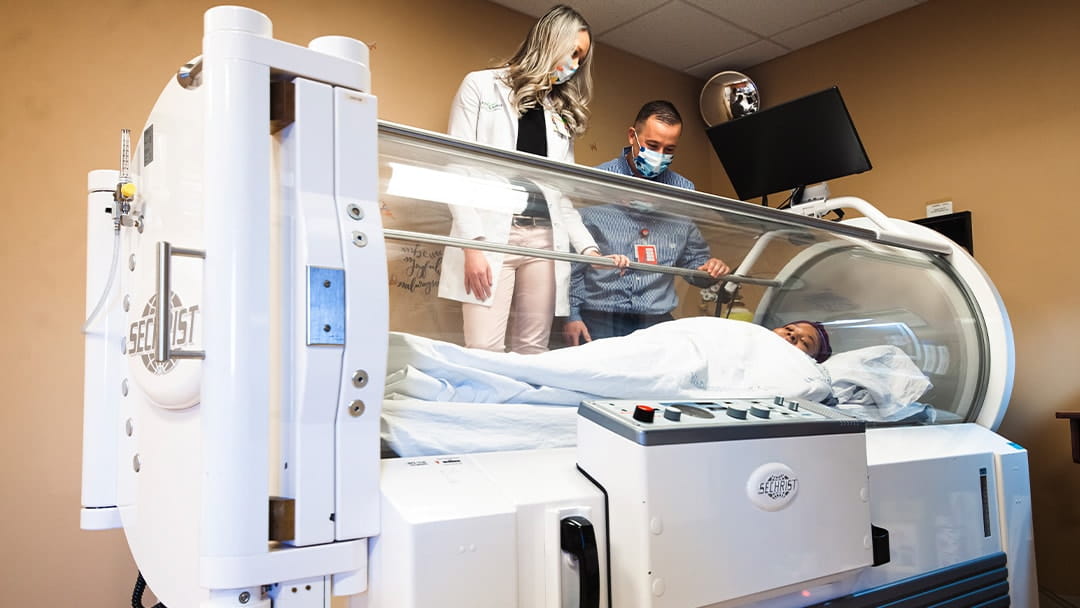Discover the Perks of Hyperbaric Oxygen Treatment for Improved Healing
Hyperbaric Oxygen Therapy (HBOT) has arised as an engaging intervention in the field of healing, supplying significant advantages through improved oxygen distribution to tissues. Comprehending the complete scope of HBOT's benefits might lead to transformative outcomes-- yet, numerous crucial factors to consider continue to be to be discovered.
What Is Hyperbaric Oxygen Therapy?
Hyperbaric Oxygen Therapy (HBOT) is a clinical treatment that entails the breathing of pure oxygen in a pressurized setting. This therapy operates under the principle that increasing the air pressure allows the body to absorb even more oxygen than it would under normal problems. Commonly conducted in a hyperbaric chamber, the person takes a breath 100% oxygen while the chamber pressure rises to degrees higher than sea level.
HBOT is mainly utilized for problems such as decompression health issues, carbon monoxide poisoning, and chronic non-healing wounds, to name a few. The treatment session usually lasts in between 60 to 120 mins and might differ in regularity depending upon the medical condition being resolved.
Throughout HBOT, oxygen is provided directly to tissues, enhancing metabolic procedures and advertising the healing action. This treatment is commonly provided by experienced health care specialists who keep an eye on the person's essential indications and make sure safety and security throughout the procedure. HBOT is a reliable therapy for particular medical conditions, it is vital to consult medical care companies for suitable examination and referrals, as not all conditions are ideal for this type of therapy.
Exactly How HBOT Boosts Recovery
The healing effects of increased oxygen degrees in a pressurized setting play a significant function in enhancing the body's natural healing processes. Hyperbaric Oxygen Therapy (HBOT) elevates oxygen saturation in the blood stream, facilitating the transportation of oxygen to tissues that might be robbed of appropriate supply because of injury or health problem - hyperbaric oxygen therapy. This increase in oxygen availability promotes cellular regeneration and the development of new members vessels, a process understood as angiogenesis, which is vital for efficient recovery

Furthermore, hyperbaric atmospheres counteract hazardous gases, such as carbon monoxide gas, while aiding in the removal of contaminants from the body. Generally, the integration of HBOT into therapy procedures can considerably enhance the recovery process, offering an extensive approach to healing and rehab.
Problems Treated With HBOT

Additionally, HBOT works in treating persistent non-healing wounds, specifically diabetic ulcers, by advertising angiogenesis and a knockout post decreasing infection danger. It is also utilized for radiation tissue injury, helping in the recuperation of clients who have undergone radiotherapy for cancer.
Other conditions consist of carbon monoxide gas poisoning, where HBOT speeds up the removal of carbon monoxide from the body, and thermal burns, as it supplies an oxygen-rich atmosphere for recovery. Additionally, HBOT has applications in dealing with serious infections such as necrotizing fasciitis, improving the effectiveness of prescription antibiotics.

Benefits for Athletes and Active People
Exactly how can athletes optimize their recuperation and performance? Hyperbaric Oxygen Treatment (HBOT) supplies a compelling solution for professional athletes and active individuals seeking to enhance their physical capacities - hyperbaric oxygen therapy. By offering a regulated environment where oxygen is delivered at higher-than-normal air pressures, HBOT increases the healing process and minimizes recuperation times from injuries such as pressures, sprains, and cracks
Among the key benefits of HBOT exists in its ability to increase oxygen supply to tissues, advertising mobile fixing and regeneration. This is specifically helpful for athletes recuperating from extreme training or competition, as it helps to alleviate swelling and muscle pain. Boosted oxygenation can boost total stamina and endurance, enabling professional athletes to train harder and much longer.
In Addition, HBOT has actually been revealed to help in the recovery from concussions and various other head injuries, making it a valuable option for get in touch with sporting activities athletes. By incorporating HBOT into their recuperation routine, professional athletes can not only jump back much more rapidly but also improve their performance degrees, setting them on a course to attain their individual bests. This treatment represents an effective tool in the toolbox of modern sports medicine.
Security and Factors To Consider of HBOT
Safety is a critical factor to consider when using Hyperbaric Oxygen Treatment (HBOT) While this look these up treatment offers many benefits, it is important to stick to details safety procedures to reduce prospective dangers. Individuals need to go through a complete medical assessment before treatment, making certain that any kind of contraindications, such as specific lung conditions or a history of ear surgery, are appropriately evaluated.
During the HBOT session, people are generally placed in a hyperbaric chamber where next air pressure is increased. This raised pressure can present dangers, including oxygen toxicity, which can lead to seizures or pulmonary issues otherwise correctly monitored. Therefore, it is essential for skilled specialists to manage the entire procedure, ensuring that people do not go beyond recommended direct exposure times.
Furthermore, patients need to notify the doctor of any medications or supplements they are taking, as some may engage negatively with HBOT. Post-treatment tracking is just as important to recognize any kind of postponed adverse effects. By focusing on safety and security and sticking to established standards, the therapeutic advantages of HBOT can be taken full advantage of while lessening possible threats, inevitably promoting a successful recovery experience.
Conclusion
Finally, Hyperbaric Oxygen Therapy (HBOT) offers a valuable technique to enhancing healing and recuperation throughout various conditions. By boosting oxygen distribution to cells and promoting mobile regeneration, HBOT effectively resolves chronic injuries, decompression sickness, and sports-related injuries. Its benefits for professional athletes, including increased recuperation times and lowered muscle discomfort, underscore its significance in maximizing health and wellness and efficiency. Proceeded study and scientific application of HBOT will certainly even more clarify its possible advantages in varied therapeutic contexts.